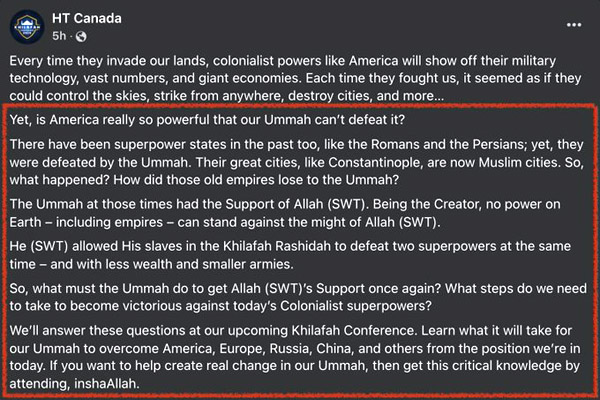As Hizb Ut Tahrir, the notorious Jihadi Islamist group advocating for a global Caliphate, prepares for a massive conference in Canada on January 18, its growing influence poses serious security concerns for India, particularly its North East region.
Hizb Ut Tahrir, which translates to “Party of Liberation,” said the theme of the conference is “eliminating the obstacles that are delaying [the] return” of an Islamic caliphate. The organization banned in several countries for its radical ideologies, has long been a source of alarm for global security experts. The group’s upcoming conference in Mississauga, Ontario, themed “The Khilafah (Caliphate): Eliminating the Obstacles Delaying Its Return,” underscores its commitment to establishing a Muslim Caliphate. This event is more than just a gathering; it highlights the group’s persistent push to unite Muslims globally under Sharia law, and its provocative stance against what it refers to as “Colonialist superpowers,” including the United States, Europe, Russia, China, and India.
While the group’s activities have been monitored globally, its influence in India—especially in the North East—raises alarms. The region, with its complex ethnic, religious, and political landscape, has long been a hotbed for insurgent and extremist movements. Hizb Ut Tahrir’s global agenda and its presence in neighboring Bangladesh, where it has grown in influence despite being banned, further heighten concerns that the North East could become a new frontier for its operations.
A Regional Security Flashpoint
The North East is no stranger to ethnic and ideological tensions. Historically, it has seen insurgencies driven by various groups with local and regional grievances. But they were indigenous , home grown outfits mostly fighting the Indian authorities / establishments to achieve political benefits. Now, with the rise of transnational jihadi ideologies, the region faces new challenges. Hizb Ut Tahrir’s ideological reach, facilitated by its proximity to Bangladesh, has already had ripple effects within India. The National Investigation Agency (NIA) recently filed charges against individuals linked to the group in Tamil Nadu, signalling the potential for further infiltration into other vulnerable regions like Tripura, Assam and Meghalaya.
In Bangladesh, Hizb Ut Tahrir has capitalized on political instability, with local activists openly calling for the establishment of a Caliphate and directing anti-India rhetoric towards its neighboring country. This cross-border influence is not limited to ideology but also manifests in the spread of extremist propaganda, creating a breeding ground for radicalization along India’s porous borders.
India’s Response: A Balancing Act
India, aware of the growing threat, has taken steps to curb the influence of Hizb Ut Tahrir. The group has been banned, and authorities have taken action against its operatives in multiple states. However, security experts argue that more must be done, especially in the North East, where insurgent activities and communal tensions provide fertile ground for extremist ideologies. Strengthening border security, increasing intelligence sharing, and fostering local community awareness about the dangers of radicalization are critical to preventing the spread of groups like Hizb Ut Tahrir.
A Global Network of Extremism
The larger international community is not immune to Hizb Ut Tahrir’s influence. Despite being banned in several countries—including the United Kingdom, Germany, and the United States—the group continues to operate with relative impunity, especially in Canada. Critics argue that allowing such groups to host conferences in democratic nations is a dangerous oversight. In Canada, for example, Hizb Ut Tahrir has faced scrutiny for hosting events that promote extremist views, with some Canadian politicians questioning why the group is allowed to operate freely while designated as a terrorist organization in other parts of the world.
The group’s appeal to young, disenfranchised Muslims by promoting an idealized vision of a Caliphate is a worrying trend. In countries like Bangladesh, where political turmoil and economic challenges have led to the rise of radical ideologies, Hizb Ut Tahrir has been able to tap into a sense of injustice and frustration, particularly among youth.
What Lies Ahead for North East India?
As the date for Hizb Ut Tahrir’s conference approaches, its implications for North East India become more pressing. The region’s strategic location, along with its historical and ongoing struggles with insurgency, makes it a prime target for groups seeking to spread radical ideologies. Moreover, the group’s ability to operate across borders—from Bangladesh to India—only complicates the task of counterterrorism.
India’s security agencies, already stretched thin in dealing with local insurgencies, must be vigilant in monitoring the rise of global extremist movements. Cooperation with Bangladesh, which is at present scenario clearly uncertain- is vital to ensure that Hizb Ut Tahrir’s activities are kept in check. However, this will require a concerted effort from both governments to dismantle the ideological and logistical networks that allow groups like Hizb Ut Tahrir to flourish. The problem is Yunus Government in Bangladesh is evidently soft pedalling and in cases encouraging the Islamic radicals including HuT.
A Call for Regional Cooperation
 For North East India, the threat posed by Hizb Ut Tahrir is part of a larger, growing challenge of cross-border terrorism and extremism. As the world confronts rising radicalism, it is crucial for regional leaders to collaborate on security matters. For India, addressing the threat of groups like Hizb Ut Tahrir requires not only stronger domestic policies but also regional cooperation with neighbors like Bangladesh. Only through united efforts can the rise of extremist ideologies be effectively curtailed.
For North East India, the threat posed by Hizb Ut Tahrir is part of a larger, growing challenge of cross-border terrorism and extremism. As the world confronts rising radicalism, it is crucial for regional leaders to collaborate on security matters. For India, addressing the threat of groups like Hizb Ut Tahrir requires not only stronger domestic policies but also regional cooperation with neighbors like Bangladesh. Only through united efforts can the rise of extremist ideologies be effectively curtailed.
The upcoming conference in Canada is a stark reminder of the global nature of the threat, but for North East India, it’s a call to action—one that requires vigilance, preparedness, and international solidarity to prevent the spread of radical ideologies in a region already fraught with complexity.
Pics taken from Open sources and HuT sites available in internet





